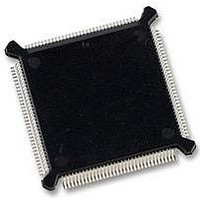MC68331CEH25 Freescale Semiconductor, MC68331CEH25 Datasheet - Page 40

MC68331CEH25
Manufacturer Part Number
MC68331CEH25
Description
IC MCU 32BIT 25MHZ 132-PQFP
Manufacturer
Freescale Semiconductor
Series
M683xxr
Specifications of MC68331CEH25
Core Processor
CPU32
Core Size
32-Bit
Speed
25MHz
Connectivity
EBI/EMI, SCI, SPI, UART/USART
Peripherals
POR, PWM, WDT
Number Of I /o
18
Program Memory Type
ROMless
Voltage - Supply (vcc/vdd)
4.5 V ~ 5.5 V
Oscillator Type
Internal
Operating Temperature
-40°C ~ 85°C
Package / Case
132-QFP
Controller Family/series
68K
No. Of I/o's
18
Cpu Speed
25MHz
No. Of Timers
1
Embedded Interface Type
QSPI, SCI, UART
No. Of Pwm Channels
2
Digital Ic Case Style
PQFP
Rohs Compliant
Yes
Processor Series
M683xx
Core
CPU32
Data Bus Width
32 bit
Data Ram Size
80 B
Interface Type
QSPI, SCI, UART
Maximum Clock Frequency
25 MHz
Number Of Programmable I/os
18
Number Of Timers
1
Maximum Operating Temperature
+ 85 C
Mounting Style
SMD/SMT
Minimum Operating Temperature
- 40 C
Eeprom Size
-
Ram Size
-
Program Memory Size
-
Data Converters
-
Lead Free Status / Rohs Status
Details
Available stocks
Company
Part Number
Manufacturer
Quantity
Price
Company:
Part Number:
MC68331CEH25
Manufacturer:
PANASONIC
Quantity:
2 000
Company:
Part Number:
MC68331CEH25
Manufacturer:
Freescale Semiconductor
Quantity:
135
Company:
Part Number:
MC68331CEH25
Manufacturer:
Freescale Semiconductor
Quantity:
10 000
3.8.1 Interrupt Acknowledge and Arbitration
40
Interrupt requests are sampled on consecutive falling edges of the system clock. Interrupt request input
circuitry has hysteresis. To be valid, a request signal must be asserted for at least two consecutive clock
periods. Valid requests do not cause immediate exception processing, but are left pending. Pending re-
quests are processed at instruction boundaries or when exception processing of higher-priority excep-
tions is complete.
The CPU32 does not latch the priority of a pending interrupt request. If an interrupt source of higher
priority makes a service request while a lower priority request is pending, the higher priority request is
serviced. If an interrupt request of equal or lower priority than the current IP mask value is made, the
CPU does not recognize the occurrence of the request in any way.
Interrupt acknowledge bus cycles are generated during exception processing. When the CPU detects
one or more interrupt requests of a priority higher than the interrupt priority mask value, it performs a
CPU space read from address $FFFFF : [IP] : 1.
The CPU space read cycle performs two functions: it places a mask value corresponding to the highest
priority interrupt request on the address bus, and it acquires an exception vector number from the inter-
rupt source. The mask value also serves two purposes: it is latched into the CCR IP field in order to
mask lower-priority interrupts during exception processing, and it is decoded by modules that have re-
quested interrupt service to determine whether the current interrupt acknowledge cycle pertains to
them.
Modules that have requested interrupt service decode the IP value placed on the address bus at the
beginning of the interrupt acknowledge cycle, and if their requests are at the specified IP level, respond
to the cycle. Arbitration between simultaneous requests of the same priority is performed by means of
serial contention between module interrupt arbitration (IARB) field bit values.
Each module that can make an interrupt service request, including the SIM, has an IARB field in its con-
figuration register. An IARB field can be assigned a value from %0001 (lowest priority) to %1111 (high-
est priority). A value of %0000 in an IARB field causes the CPU to process a spurious interrupt
exception when an interrupt from that module is recognized.
Because the EBI manages external interrupt requests, the SIM IARB value is used for arbitration be-
tween internal and external interrupt requests. The reset value of IARB for the SIM is %1111, and the
reset IARB value for all other modules is %0000. Initialization software must assign different IARB val-
ues in order to implement an arbitration scheme.
Each module must have a unique IARB value. When two or more IARB fields have the same nonzero
value, the CPU interprets multiple vector numbers simultaneously, with unpredictable consequences.
Arbitration must always take place, even when a single source requests service. This point is important
for two reasons: the CPU interrupt acknowledge cycle is not driven on the external bus unless the SIM
wins contention, and failure to contend causes an interrupt acknowledge bus cycle to be terminated by
a bus error, which causes a spurious interrupt exception to be taken.
When arbitration is complete, the dominant module must place an interrupt vector number on the data
bus and terminate the bus cycle. In the case of an external interrupt request, because the interrupt ac-
knowledge cycle is transferred to the external bus, an external device must decode the mask value and
respond with a vector number, then generate bus cycle termination signals. If the device does not re-
spond in time, a spurious interrupt exception is taken.
The periodic interrupt timer (PIT) in the SIM can generate internal interrupt requests of specific priority
at predetermined intervals. By hardware convention, PIT interrupts are serviced before external inter-
rupt service requests of the same priority. Refer to 3.2.7 Periodic Interrupt Timer for more information.
Freescale Semiconductor, Inc.
For More Information On This Product,
Go to: www.freescale.com
MC68331TS/D











